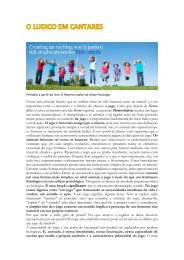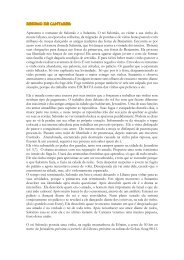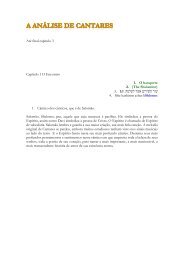Motherhood in Childhood
Create successful ePaper yourself
Turn your PDF publications into a flip-book with our unique Google optimized e-Paper software.
decreased the chances of their marry<strong>in</strong>g and hav<strong>in</strong>g<br />
children.<br />
In a later study <strong>in</strong> Kenya, Duflo et al. (2011)<br />
found that simply provid<strong>in</strong>g children with school<br />
uniforms was sufficient to <strong>in</strong>crease enrolment,<br />
reduce the drop-out rate by 18 per cent and lower<br />
the pregnancy rate by 17 per cent. “The children<br />
already enrolled <strong>in</strong> sixth grade classes were given<br />
a free uniform. Implementers also announced<br />
that students still enrolled <strong>in</strong> school the follow<strong>in</strong>g<br />
year would be eligible for a second uniform, and<br />
distributed uniforms aga<strong>in</strong> the follow<strong>in</strong>g year.”<br />
(Duflo et al., 2011) The reduction <strong>in</strong> the number<br />
of pregnancies, however, occurred “entirely<br />
through a reduction <strong>in</strong> the number of pregnancies<br />
with<strong>in</strong> marriage” as “there was no change <strong>in</strong><br />
the out-of-wedlock pregnancy rate.” This f<strong>in</strong>d<strong>in</strong>g<br />
suggests that education’s protective power lay <strong>in</strong><br />
its ability to reduce child marriage rates, which <strong>in</strong><br />
turn helped reduce adolescent pregnancy. Duflo<br />
et al. concluded that “giv<strong>in</strong>g girls…the opportunity<br />
to go to school if they want to do so is an<br />
extremely powerful (and <strong>in</strong>expensive) way<br />
to reduce teen fertility.”<br />
Girls reap many immediate and long-term benefits<br />
from education, which, dur<strong>in</strong>g adolescence, is<br />
a necessary first step for girls to overcome a history<br />
of disadvantage <strong>in</strong> civic life and paid employment<br />
(Lloyd, 2009). Enhanc<strong>in</strong>g the quality and<br />
relevance of learn<strong>in</strong>g opportunities for adolescents<br />
can prepare and empower girls for a range of adult<br />
roles beyond the traditional roles of homemaker,<br />
mother, and spouse, with benefits not just for the<br />
girls, but also for their families and communities.<br />
Be<strong>in</strong>g <strong>in</strong> school along with boys dur<strong>in</strong>g adolescence<br />
fosters greater gender equality <strong>in</strong> the daily<br />
lives of adolescents. Education for adolescent girls<br />
helps them avoid early pregnancies, and lowers<br />
their risk of HIV/AIDS.<br />
While primary education is a basic need for<br />
all, secondary education offers greater prospects<br />
of remunerative employment, with girls receiv<strong>in</strong>g<br />
substantially higher returns <strong>in</strong> the workplace<br />
than boys when both complete secondary school.<br />
Gupta et al. (2008) found that “education<br />
cont<strong>in</strong>ues to be the s<strong>in</strong>gle most important predictor<br />
of age at marriage over time.” School<br />
enrolment has a protective value <strong>in</strong> that school<br />
girls are “seen as children and not of marriageable<br />
age” (Marcus and Page, 2013). Accord<strong>in</strong>g to one<br />
study <strong>in</strong> Kenya (Duflo et al., 2011), “once one<br />
leaves school, sex and marriage are expected.”<br />
Decades of research have shown that education<br />
and school<strong>in</strong>g are key factors for not only<br />
reduc<strong>in</strong>g the risk of early sexual <strong>in</strong>itiation,<br />
pregnancy, and early childbear<strong>in</strong>g, but also for<br />
<strong>in</strong>creas<strong>in</strong>g the likelihood that adolescents will<br />
use condoms and other forms of contraception if<br />
they do have sexual <strong>in</strong>tercourse (Blum, 2004).<br />
Other actions, such as conditional cash transfers,<br />
aimed at keep<strong>in</strong>g girls <strong>in</strong> school have also<br />
protected girls from pregnancy. Conditional<br />
cash transfers are regular monthly or bi-monthly<br />
payments, which are cont<strong>in</strong>gent on families<br />
avail<strong>in</strong>g themselves of basic services, such as<br />
school, primary health care, sexual and reproductive<br />
health services, or free awareness-rais<strong>in</strong>g<br />
or education sessions.<br />
Malawi, for example, piloted a conditional<br />
cash transfer programme to encourage girls<br />
<strong>in</strong> the Zomba district to stay <strong>in</strong> school or to<br />
encourage recent dropouts to resume their education.<br />
Zomba has a high dropout rate, low<br />
educational atta<strong>in</strong>ment, and the country’s highest<br />
HIV prevalence rates among women ages<br />
15 to 49. Through the Zomba programme,<br />
households received a $10 monthly transfer,<br />
equivalent to about 15 per cent of the<br />
60 CHAPTER 4: TAKING ACTION

















